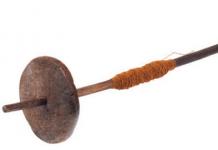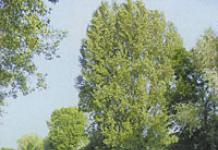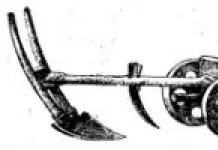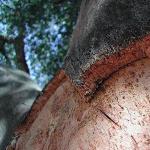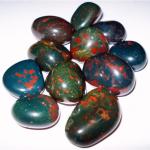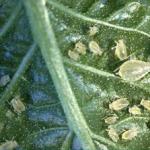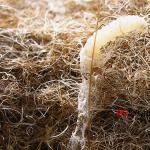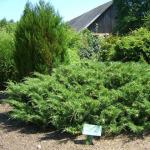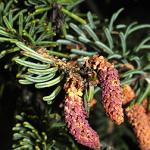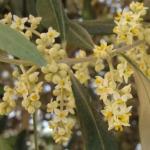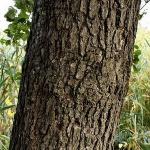Here larisa_revina writes: This season we have a terrible invasion of aphids in incredible quantities. Now, while removing tops from the beds and weeds from uncultivated areas, I discovered that the entire earth (in places where they are large) is covered with a white coating. This is probably an infection... How to cultivate the soil in the beds and the territory of the future flower garden, which is planned for digging in the winter?
Aphids overwinter in the fertilized egg phase. The eggs are oval, shiny, black, up to 0.5 mm long. They are easy to spot on the bark of shoots. Considering that aphids multiply exponentially. Each female gives approximately 100 individuals, and after 10-15 days, each new one itself gives another 100 individuals, and so on from early spring to late autumn. Thus, each overwintered female aphid produces up to 17,000 pests per season.
Let's start by clearly defining where the aphid overwinters, or rather its eggs, from which in the spring, as soon as stable warmth sets in, young individuals will hatch and begin to feed on plant sap.
1. Aphids lay eggs on the branches of trees and shrubs in the area of leaf buds. In severe winters, some of them may die, but even a small number of surviving eggs will give rise to a whole colony of pests.
2. Most of the eggs are spent overwintering on root shoots and tops.
3. Garden ants bring aphid eggs into their anthills, where they hide them from the cold and enemies. And in the spring, it is they who spread the aphids in order to milk them for their food.
Natural enemies of aphids are the larvae and ladybugs themselves, lacewings, hoverflies, earwigs, flies and wasps. By the way, the fact that enemies have worked on aphid plantations can be seen from the dirty whitish coating on the leaves or soil, which is the remains of the pest’s corpses. Now is the time to provide them with a good winter by placing houses and pots with large shavings.
Inspect the shoots of currants, plums, cherry plums and other plants damaged by aphids in the summer. Cut off all twisted branches and burn them. Thoroughly clear the remaining branches of oviposition. Be sure to whiten the trunks and bases of skeletal tree branches with lime milk.
Methodically cut out all root shoots and tops, be sure to burn them or send them to a landfill.
Destroy anthills, before frost, pick them out with a stick and fill them with water, and in early spring start fighting garden ants, preventing them from spreading aphid eggs into the trees.
Review your garden plan. Please note that aphids actively reproduce on plants such as cosmos, poppy, mallow, nasturtium, linden, and viburnum. Try to plant them as far as possible from crops that are most affected by aphids. We must always take into account that there are species of aphids that feed on some plants and reproduce on others. You can reduce the number of aphids in the garden only if you have few plants that are “homes” for the rapid reproduction of this pest.
Therefore, destroy as much as possible all the weeds in the garden, plant crops such as sunflower, Jerusalem artichoke, chamomile, chrysanthemums, and most plants from the family Lamiaceae (Labiaceae) to a minimum. Plant lettuce and chicory, herbs from the Lamiaceae family, as far as possible from currants. Watch for the appearance of aphids on water lilies, egg capsules and other aquatic plants, destroy them in a timely manner, because it is on these plants that plum aphids reproduce.
As you can see, there is no need to cultivate the soil in any way to destroy the egg-laying of aphids. But there is a lot of work. And there will be even more of it in spring and summer, when you will need to regularly spray plants against aphids and knock them off the shoots of trees and shrubs with a stream of cold water.
These are miniature creatures, with a body length from 0.5 mm to 7 mm, but more often no more than 3 mm, body shape resembles a drop, pointed at the posterior end. See the photo on the right for what the aphid looks like.
Description of insects may be different. Depending on the conditions of existence, they can be wingless or have 2 pairs of transparent wings, with the back pair always shorter than the front. Pictures with their image can be seen below in this material. Aphids on leaves can completely destroy a tree or plant.
The color is very diverse - black, green, pink, red, or even the insect is completely transparent. On the head are dark eyes and a pair of antennae.
Is there a useful We'll find out about aphids later.
Photo of aphids
How do they reproduce?
Reproduction of aphids occurs as follows. Aphids overwinter in the form of eggs, deposited in a secluded place - on the roots of plants or in cracks in the bark of a tree.
In the spring, a wingless female founder of the colony emerges from the egg, and begins to give birth to living larvae, from which only wingless virgin females emerge.
They got such an interesting name because that they do not need a male to give birth to larvae, and in summer they give birth only to females. Read on to find out how long aphids live.
Rapidly multiplying - and one virgin female lives for about a month and gives birth to 50 to 100 larvae- aphids form a colony.
 The aphid larva is a smaller copy of the adult and grows quickly, periodically shedding its skin. After 10-15 days a new individual also ready to reproduce.
The aphid larva is a smaller copy of the adult and grows quickly, periodically shedding its skin. After 10-15 days a new individual also ready to reproduce.
When the size of the colony becomes critical, winged female virgins are born and, flying to other plants, they give rise to new colonies. And only in the fall, when unfavorable conditions occur, real females are born in the colony and real males, capable of mating and laying eggs, which will overwinter.
Over the summer, up to 20 generations often occur from one founder, and her offspring number in the hundreds of thousands.
How and what does he eat?
Each individual is equipped with a piercing proboscis for feeding plant sap. Some aphids feed on only one type of plant, some on two, and many can suck the juices from a whole group of suitable plants.
Excess ingested juice is released in the form of a sticky sugary droplet - honeydew or honeydew(or milk of aphids), which ants love to feast on.
Where do they come from?

There are a large number of and some of them switched to cultivated plants. What are the causes or what causes aphids?
Most often, aphids enter plantings with new, plants that have not been tested for infection. An old, unkempt area is always contains a large number of aphids and infects neighboring areas.
Especially since Ants help aphids to settle, transferring them to new plants.
Why are they dangerous?
The damage caused by aphids is quite great. New colonies form on the lower surface of the leaves, so they are not immediately noticeable.
Aphids produce toxins that cause changes in the shape of plant organs. First of all, aphids attack young shoots, buds, flowers. The leaves begin to curl, the buds fall off without opening, the flowers become curled, and the fruits do not set.
With a high number of colonies, crop growth may be suspended. Spots or yellow mesh appear on the leaves, honeydew secretions contaminate the leaves and interfere with normal light absorption, In addition, black sooty fungus or other molds settle on them.
Shoots affected by aphids are weakened and freeze more strongly in winter. Such plants get sick more often. Aphid infestation can kill a cultivated plant.
Some species of aphids form galls- tumors on the shoots, from which ulcers subsequently form, which can lead to the death of the plant.
The big danger is that aphids can carry dozens of plant viruses!
Who is attracted to or eats the pest?
Natural enemies of aphids are some insects and songbirds. Birds can be attracted by feeders and planting berry bushes.
Among the insects, it is worth mentioning ladybugs, lacewings, certain types of ichneumon fly - the genera Aphelinus, Aidius, Lysiflebus, Praop, Matricaria, hover flies, mantises, predatory gall midges, ground beetles, and earwigs.
Planting plants that are attractive to these insects should also produce good results.
The ground beetle prefers nightshade plants, Earwigs love to settle in flower pots with wood shavings; such pots can be placed under trees; hover flies happily feed on daisy pollen. Effective in the fight against aphids and.
What is he afraid of?
The smell of some plants is not acceptable to aphids - these are onions, garlic and Dalmatian chamomile. If you plant or place Dalmatian chamomile in pots next to the seedlings, the aphids will disappear.
 But there are plants, on the contrary, that are very attractive to aphids, a kind of “distraction”.
But there are plants, on the contrary, that are very attractive to aphids, a kind of “distraction”.
These are nasturtium, cosmos, poppy, mallow, tuberous begonias, as well as viburnum and linden. Alternating their plantings, you can reduce the likelihood of aphid attacks for garden and vegetable crops.
Plant species that attract aphids should not be planted next to protected ones. Although nasturtiums are sometimes planted around fruit trees, so that aphids immediately settle on them. In the future, herbaceous plants along with aphid colonies can be easily mowed down and destroyed.
There are also various methods and methods for getting rid of aphids: agrotechnical, biological, mechanical and chemical.
Conclusion
It is precisely due to its high fertility that the small defenseless insect poses a serious problem for agriculture.
But by competently applying both the principles of organic gardening and industrial insecticides, you can count on successful cleaning of your field or garden from annoying enemies of the harvest.
Useful video!
Any gardener, whether a beginner or an experienced one, makes a lot of efforts to ensure that indoor flowers grow and develop normally and at the same time are healthy and beautiful. However, it happens that pests settle on the bushes, because of which their decorative properties suffer, and because of them, the plants can become very sick and, in some cases, die. Aphids are one of the most common pests. Therefore, a gardener may often have a question: how to quickly eliminate aphids that have appeared on a house plant? The most effective and safest methods will be described below.
An aphid is a small insect with an oblong body, long legs, and its abdomen is wide and pointed. Most often, white aphids settle on house flowers, but there are many other species, both wingless and winged. The insect can be colored green, pink, pale yellow and black. Although aphids may differ from each other in appearance, they harm indoor flowers equally strongly. Such a pest makes a puncture in a shoot or leaf blade and sucks out plant sap, which weakens the flower.
The pest is distinguished by its ability to quickly adapt to any habitat and its incredibly fast reproduction. It forms entire colonies. Just one female is capable of laying up to 100 larvae, and each of them becomes an adult in just half a month. Winged aphids are engaged in discovering and capturing new places suitable for life and food, and the function of wingless aphids is to reproduce offspring. Most often they settle on buds and young shoots, and they can also be found on the underside of leaf blades.
Where do aphids come from?
Many gardeners do not know where aphids can appear on a home flower? This can happen for a variety of reasons. For example, a winged female may well fly into an open window or balcony. An insect can also get into the house on the fur of a pet, or even the person himself can carry it on his clothes or other things. Aphids can be found on a recently purchased flower or on a bouquet given to you, and they are also sometimes present in the substrate used for planting or replanting flowers. There is a high probability of aphids appearing if you move flowers outside during the warm season, and then bring them back into the house with the onset of cold weather. There are also types of ants that love to feast on the excess juice sucked out by the pest (honeydew), and it has been observed that they themselves transfer aphids to various plants.
Prevention measures:
- In order to prevent aphids from appearing on your “green pets,” it is recommended that newly purchased plants be quarantined. To do this, they are placed away from other flowers for a while. It is also recommended to give this plant a warm shower.
- The soil mixture that you are going to use for planting or transplanting should be placed in the freezer for a while. Severe cold can clear the substrate of both adults and larvae.
The main signs of aphids
In order to quickly get rid of aphids, you need to detect them as quickly as possible and immediately begin to fight them. To do this, it is recommended to systematically inspect your home plants. If you are lucky enough to find aphids when there are still very few of them, then all you need to do to get rid of them is to crush the adults, as well as all the larvae. If possible, cut and destroy the affected parts of the bush. But in the case when there are a lot of pests on the plant, more effective methods will be needed to get rid of them. There are several signs by which you can understand that there are aphids on a flower:
- The plant becomes less attractive and looks sickly.
- On the surface of the above-ground part of the bush you can find very small punctures that aphids leave during their life processes.
- The surface of the stems and foliage becomes sticky from the honeydew, their color gradually changes to black, they curl up and dry out.
- The open buds become smaller and deformed; they quickly fade and fly off.
- Near the affected plant you can find ants who are trying to get their favorite treat.
Aphids can greatly harm any home flower. This pest is considered one of the main carriers of viral and fungal diseases. For example, in those areas where honeydew appears, sooty fungus forms. Aphids pose the greatest danger to indoor crops such as orchids, roses, fuchsias, hyacinths, palmaceae, hibiscus, chrysanthemums, spathiphyllums and cyclamens.
As soon as aphids are found on the plant, it should be moved away from other flowers so that the pests cannot settle in them. After this, you can begin to fight insects.
To save a houseplant on which aphids were found, you must begin to combat this dangerous pest as soon as possible. To get rid of it you will have to spend a lot of time and effort, but it is not so difficult to do. Flower growers use various means for this, which can be divided into three categories, namely: chemical, mechanical and folk. There is also a radical way to do this by completely destroying the flower that has been infested by aphids if there is no chance of saving it.
Most often, at the beginning, a mechanical method is used, after which folk remedies are used. If these methods turn out to be ineffective, then they resort to the use of special chemicals that can eliminate aphids very quickly, both adults and larvae. To increase the effectiveness of the chemical, they not only treat the bush itself, but also spill the substrate in the pot. This measure is justified if white aphids have settled on the bush.
The mechanical method of cleaning a bush is effective only if there are very few harmful insects on it. To do this, you need to trim off all the affected parts of the flower if possible, and you should also give it a daily shower until the aphids completely disappear.
The most effective would be a shower using laundry soap, because this pest does not like it at all. It's important to do everything right. First, prepare a soap solution by combining water and soap in a ratio of 6:1. To protect your hands, wear rubber gloves. Moisten a piece of cloth in a soapy solution and wipe the affected buds, shoots and foliage with it, trying to remove all insects. After this, the bush is washed under running water. If necessary, this procedure can be carried out regularly until there are no pests left on the flower. However, make sure that the soap solution does not get into the substrate. During processing, remember that aphid larvae are often found in hard-to-reach places, so you must inspect every leaf and bud, while cutting off and destroying those that have the pest.
Treatment with medical alcohol is also a mechanical method. It cannot damage the sheet plates because it evaporates almost immediately after application.
Often, folk remedies turn out to be ineffective in the fight against aphids. However, when there is still very little of it on the plant, they may well help get rid of it. Many gardeners choose folk remedies because they are environmentally friendly. There are many time-tested means, for example:
- Tobacco. Water should be combined with tobacco in a ratio (2:1) and everything should be mixed well. The infusion will be ready after two days; all you have to do is strain it and dilute it with water (1:1). The product can then be used to treat home flowers. Be extremely careful that the infusion should not get into the substrate, as this may damage the root system. In this regard, it is recommended to cover the surface of the soil mixture during processing.
- Garlic. 30 grams of unpeeled garlic cloves should be crushed to a pasty state using a blender or meat grinder. The mass is combined with a liter of water and placed in a dark place to infuse for 24 hours. The infusion should be combined with a small amount of grated soap. You need to treat the affected bush 2 or 3 times with a break of 5 days.
- Lemon (orange) peel. Take 100 grams of lemon or orange peels and combine them with not too much water. Place the mixture in a warm place for three days. When the infusion is ready, they need to process the flower.
- Red hot pepper. 100 milligrams of water are combined with 50 grams of crushed pepper. The mixture should boil over low heat for 60 minutes. After this, it is left to infuse for a day and filtered. To prepare the solution, you need to combine 10 liters of water with 10 milligrams of decoction.
- Wood ash. To prepare the solution, you need to combine 50 grams of crushed or liquid soap, 500 ml of wood ash and 1 bucket of water. After the solution is filtered, you can spray the bush with it.
- White mustard. 10 grams of dry powder are dissolved in a liter of water. The mixture is removed for two days to infuse. When it is filtered, you can begin processing. If there are a lot of pests, then the infusion can be used undiluted, but in other cases it must be combined with a not very large amount of water before processing.
- Needles. A couple of liters of water are combined with 0.4–0.5 kg of pine or spruce needles. The infusion will be ready after a week. It is filtered and diluted with water in a ratio of 1:7. To completely get rid of pests, plants need to be sprayed several times with an interval of three or four days.
- Celandine. A liter of water is combined with 350 grams of fresh celandine or 150 grams of dry, the grass must first be crushed. The mixture is placed in a dark place for 24 hours. The affected flower is treated three times.
- Tomato tops. Combine a liter of water with half a kilogram of chopped tops. Boil the mixture over low heat for half an hour. Place the broth in a dark place and wait until it cools completely. During processing, you can pour 3-4 mg of liquid soap into it.
It has been noted that such a pest is repelled by the smell of geraniums and marigolds. In this regard, it is recommended to place such a plant in a pot near the affected flower. Aphids also do not like the aroma of dill, parsley and mint.
It is recommended to use chemicals in the fight against aphids only when folk remedies have proven ineffective. Among the various drugs there are both gentle and aggressive. For example, Preparation 30 Plus mineral oil does not harm flowers at all.
The choice of product is influenced by the level of infestation and the number of pests. In the fight against aphids on house plants you can use: Iskra, Decis, Akarin, Confidor, Fitoverm, Neoron, Inta-vir, Actellik, Karate and others. When using Confidor, Actellik and Karate, you need to take into account that they have an extremely unpleasant odor; therefore, spraying is carried out in a well-ventilated room. Processing should be carried out warmly (from 21 to 25 degrees). In a cooler room, the drugs will not be as effective.
When using insecticides, you must be extremely careful:
- there should be no animals or children in the room;
- Before processing, read the instructions on the package;
- put on gloves and a respirator;
- treat both affected and healthy bushes.
Before you start spraying, wipe the foliage and shoots with a damp cloth or wash with soapy water. As a rule, after the first spraying, only adult individuals die, while the larvae remain. In this regard, several treatments from 2 to 3 with a break of a week will be required. If a certain drug does not give the desired result, it should be replaced with another, because aphids very quickly get used to the same insecticide.
Carry out a systematic inspection of indoor plants, especially carefully inspecting sick and weakened bushes. And:
- regularly ventilate the room, as aphids love stuffiness;
- systematically moisten the bushes with a sprayer and sometimes give them a warm shower;
- you should be alerted by the appearance of ants in the room;
- send all new flowers to quarantine;
- For prevention purposes, systematically treat plants with one of the folk remedies.
Aphids are certainly one of the ten most common, tenacious and annoying pests. These small insects feed on plant sap and can infect almost any part of them: leaves, stems, buds, flowers, roots. Aphids especially love young plants, which, as a rule, attack tender shoots and the underside of leaves. Visually, aphid infestation is easy to notice - in addition to the pests themselves, there is curvature and weakness of the shoots, downward curling of the edges of the leaf blade, and spots of black mold.
U aphids an oval soft body, with antennae on the head, and a pair of ovipositors at the end of the abdomen. Some individuals have underdeveloped wings, other copies wingless. Laying eggs aphid produces in the fall, the further development cycle will continue after wintering, in the spring. Offspring aphids becomes sexually mature already 7-8 weeks after birth.
It sucks juice from plants by piercing tissues with a hollow proboscis or the tip of an ovipositor. It feeds almost continuously and is capable of absorbing a fairly large volume of plant sap. Discharge aphids are a sticky, sweetish liquid fall . This is the one " honeydew"who is adored black ants– they protect aphid colonies. The parts of the plant become sticky, over time they develop spots black mold. Aphid colonies can move from plant to plant, carrying with their saliva viral diseases.
At my own dacha I don’t want to use it to combat aphids chemical. These connections are extremely toxic and cause harm not only aphids, but also other insects, birds, settle in the soil and become dangerous for plants and people. Therefore, let's consider other methods destruction aphids on a summer cottage.
Aphid fears plants with insecticidal properties - This Dolmatian chamomile, onion, garlic, calendula, wormwood. It is very good to plant these plants next to fruit bushes or other plantings which it is desirable to protect from aphids.
Question about attracting birds to the site to destroy aphids may be considered controversial: birds that feed aphids themselves and feed their chicks with it, of course, can significantly reduce the amount aphids, but they are the same applied by pecking fruits and berries.
Among insects natural enemies aphids are ladybugs (both adult insects and their larvae feed on aphids), ichneumon wasps, ground beetles, lacewings, some types of wasps, predatory bugs, surfflies. To attract them, fragrant plants are planted on the site ( parsley, dill, carrots and others), as well as green manure plants (buckwheat, mustard, clover, alfalfa).
To prepare a soap solution 300 g of laundry soap is dissolved in ten liters of water, the ground around the plant is covered with a film and the resulting solution is sprayed on the plant. The solution is suitable for use within a week; if one spraying fails to destroy all aphids, the procedure should be repeated.
Gives good results pollination of plants with crushed and sifted . This procedure is carried out early in the morning, while the dew has not yet dried, and in the evening, after preliminary spraying of the plants..
Used to combat aphids and celandine solution : Finely chop 5-6 young fresh plants, add 3 tablespoons of laundry soap shavings and leave it all in a bucket of warm water for up to 5 hours. The resulting infusion is filtered and young shoots and tops of plant branches are dipped into it..
Hot pepper infusion to kill aphids prepare as follows: 8-10 pods of red cayenne pepper are crushed together with seeds, add 50 g, pour one liter of boiled warm water and leave to infuse for a day. The finished strained solution is used for spraying plants - in addition to aphids, it is effective against beetle larvae, slugs, caterpillars, codling moths, garden bugs and thrips.
To prepare garlic infusion 5-6 cloves are passed through a press, 1 tablespoon of vegetable oil and half a liter of warm water are added, shaken well and left in a dark place for three days. 2-3 tablespoons of strained garlic infusion and 1 tablespoon of liquid soap are diluted in 1 liter of water, and the resulting solution is sprayed onto the plants..
Infusion of potato tops for spraying plants This is done like this: take 2 kg of chopped tops in a bucket of warm water, leave for 3-4 hours and filter.
Can be cooked infusion for spraying and from tomato tops : Half a kilo of green chopped tops is poured into a bucket of boiling water and kept on low heat for 30 minutes, allowed to cool and filtered. Before spraying, a glass of the resulting infusion is diluted with 1 liter of water..
Removing aphids from a site is a long process that requires patience and great effort on your part.. It is unlikely that it will be possible to solve this problem “in one fell swoop”; repeated treatments will be required. But this is how it is applied minimal damage to nature, and the gifts of your beds and garden will not be contaminated with dangerous chemicals».
Success in hard work and an excellent harvest!
Green aphids feed on the sap of young shoots and leaves
We remove pests from beds and gardens
Important! Scientists say there are about 450 species of leaf aphids in the northern hemisphere, which can cause significant damage to agriculture, horticulture and forestry. And in a small summer cottage, if nothing is done, it will simply destroy everything.
We analyze the situation
Why and where does it appear?
Leaf aphids pierce the soft flesh of the plant with their proboscis and the neighbor sap from it. She is not interested in old rough leaves - only buds and young leaves. Based on this, the farmer’s task is to protect these parts of the plant.
How to get to the site
In most cases, aphids are brought into the area by ants. They do this not by accident, but with an absolutely specific purpose - to feed on the sweet syrup that aphids leave behind, consuming plant sap. This means that the fight against aphids begins with an attempt to separate aphids and ants in the area.
Volunteer helpers

Ladybug eats aphids
The outside world is brilliantly harmonious and you need to be able to use it. It is known that aphids have their own natural enemies; it is necessary to create favorable conditions for their reproduction. For example, aphids and ladybugs will not get along in the same area.
Spraying means
Soap solution + ash
A composition is prepared from 300 g of ordinary laundry soap and 10 liters of water. There is a more modern interpretation of this recipe: 125 ml of liquid soap per 10 liters of water.

Herbal infusions
- Onion. Onion peels and 35 g of chopped onion are poured into 1 liter of water and infused for 5 hours. Then 3-5 g of laundry soap is added. The composition is filtered and brought to a volume of 1 liter with water.
- Chamomile. Add the dry stem and inflorescences of chamomile to 1 liter of water. The composition is infused for 12 hours, then filtered and a little soap (4-5 g) is added. This concentrate is diluted before spraying at the rate of 1 part infusion to 3 parts water.
- Garlic. 200 g of garlic are crushed. This paste is diluted with 1 liter of water and infused under the lid for 5 days. Before spraying, prepare a composition of 25 ml of garlic concentrate + 10 liters of water.
- Marigold. For half a bucket of crushed marigolds (stems + flowers), there is half a bucket of water. Infusion time – 48 hours. Strain, add 40 g of soap, dilute in 10 liters of water.
- Peppery. Fresh capsicum is suitable - 1 kg or 300 g dry. Amount of water – 10 l. Before spraying, the infusion is diluted at the rate of 1:10.
Attention! Previously, tobacco tincture was very popular, but today it is out of fashion. It is believed that nicotine is present in tobacco leaves; it is transferred to the water infusion, and through it is absorbed by the leaves of vegetable and garden crops. As a result, this harmful substance enters the fruits and then into the human body.
Fighting house aphids
Unfortunately, small black, yellow or green insects also inhabit our homes. She takes a fancy to domestic flowers, causing them serious damage. Another unpleasant surprise is that some species of aphids inhabit only one plant, the so-called host. And there are those that apply to any indoor flowers indiscriminately.
Attention! Aphids are insects whose body length can be from 0.5 to 2 mm. She has a soft body. There are winged and wingless species. There are about 4 thousand species of aphids in the world. Of these, more than 1 thousand live on the European continent.

Aphids reproduce very quickly - in this case, the plant will at least be sick for a long time after spraying
We use improvised means
- Milk-iodine solution. For 1 liter of fresh, preferably skim milk, there are 25-30 drops of iodine. Green pets are treated with this composition every 10 days.
- Vodka. It is a well-known “cure-all remedy.” Usage – it couldn’t be easier. Place a spray bottle on the bottle and treat the plants. Experts say that the effect is beyond praise. The only negative is that it is a little expensive when compared with other folk remedies.
- Coca Cola. This is an American option for getting rid of aphids on house plants. You need to act by analogy with vodka. Place a spray bottle on the drink bottle and spray the plant. The effectiveness is explained by the presence of orthophosphoric acid in the composition, which is destructive to the nasty small “midges”.
- Cream + essential oil. For 1 glass of fresh cream there are 15 drops of lavender (tea tree, cedar) essential oil. The composition is diluted with 2 liters of water. Spraying must be done every other day. The result will not keep you waiting.
- Sunflower oil + water. Press 1 glass of sunflower oil into 8 liters of water and stir well. The product is suitable for washing trunks and spraying leaves. Fans of the method claim that it is enough to apply this aphid remedy 2-3 times during the warm season.
Attention! The intensity and frequency of the fight with any folk remedy depends on the stage of infection. If you pay attention to the problem in time, the pest can be removed mechanically - simply wipe the plant with a gloved hand. A solution of laundry soap can be used as a preventative measure.
Companion plants will repel aphids
Our grandmothers also knew how to get rid of aphids quickly and forever - you just need to put a pot of fragrant pelargonium on the windowsill. This flower, which forms inflorescences almost all year round, will repel aphids and other pests (midges, mosquitoes, moths), and will also delight the eye with bright inflorescences.

Oregano or basil will repel aphids
In the garden you definitely need to find a place:
- herbs – rosemary, oregano, mint;
- nettle;
- green manure – alfalfa, faba beans, clover, sweet clover, buckwheat, rye, mustard, etc.
And most importantly: the aphid population develops instantly, so at the first signs of damage it is necessary to take effective emergency measures. Better yet, it is necessary to periodically carry out preventive spraying so as not to face the need to solve such a problem in principle.
